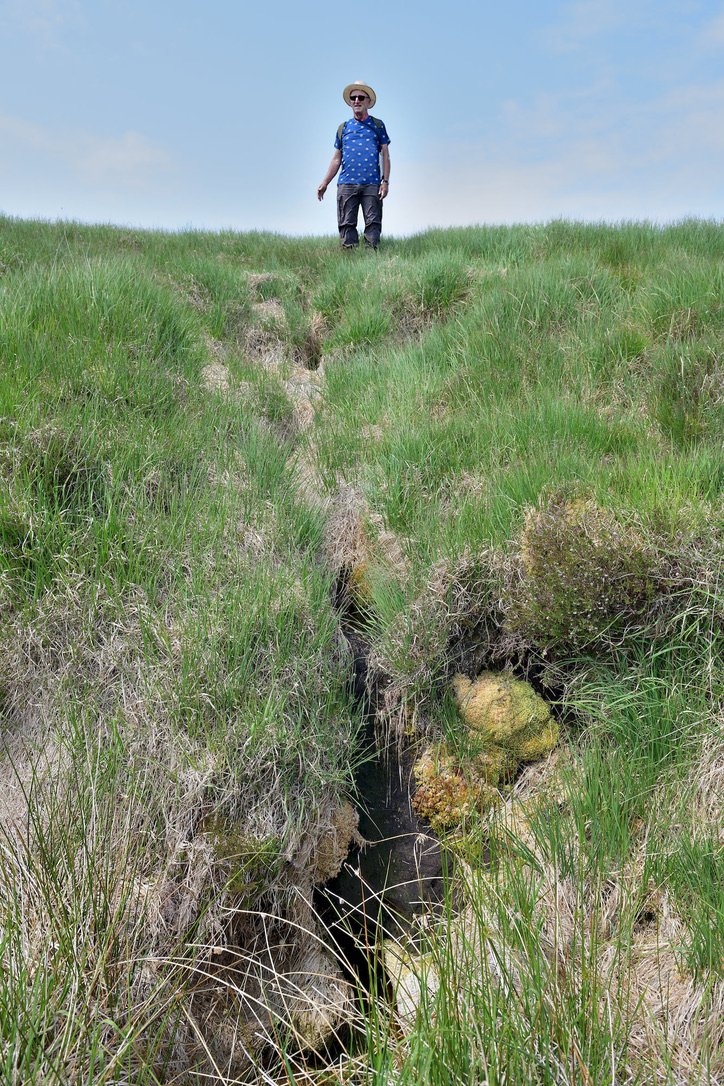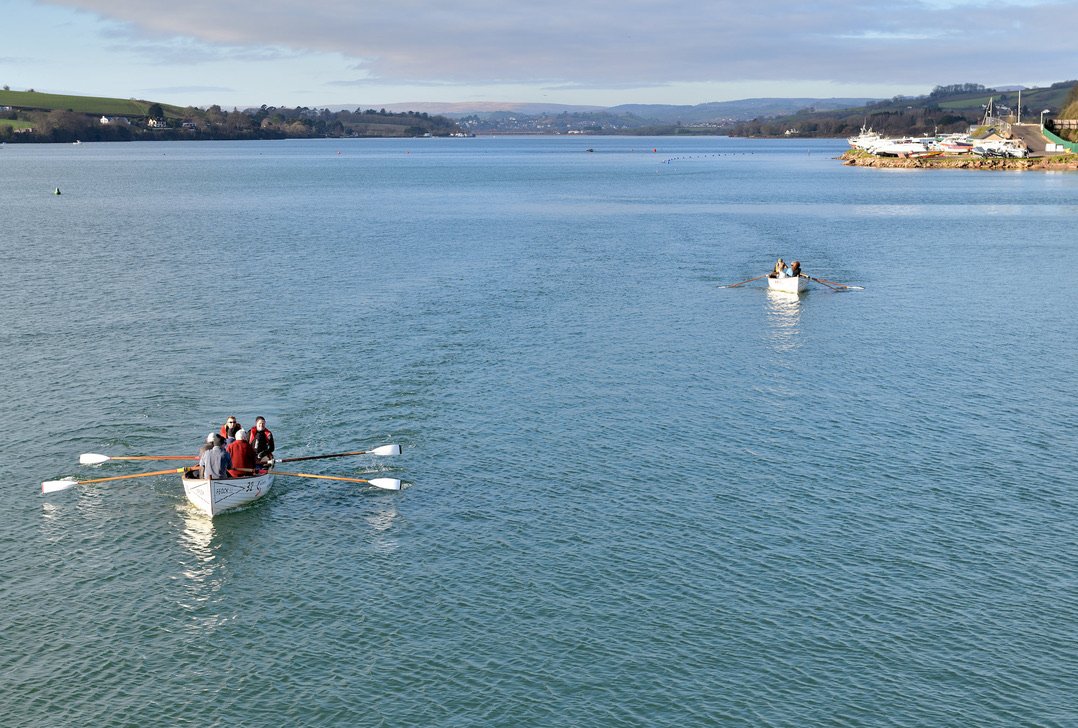We just need some water
As I’ve posted this it has begun to rain! - Classic timing!
Dartmoor, one of Britain’s most iconic national parks (other national parks are available!), is a landscape and environment shaped by water.
To most people, it’s often thought of as a rugged expanse of granite tors and sweeping moorland. More importantly, it is also the birthplace of many rivers that forged local ecosystems and communities. Among them is our beloved River Teign, which begins its journey from 2 sources. The North Teign, which rises from Teignhead high in the Dartmoor National Park, confluences with the South Teign (the other source) west of Chagford. The South Teign was dammed to create Fernworthy Reservoir in 1942. From the confluence of the North & South Teign rivers, the main river Teign continues to flow to the sea at Teignmouth.
TACA’s very own Neil Yeandle at the source of the North Teign, high on Dartmoor
The same river at Teignmouth with Dartmoor clearly visible in the background
But this river - and many others like it - can only survive if Dartmoor receives and retains enough water to sustain the flow from source to sea. With today’s ever-evident seasonal changes bringing longer, drier spells, especially during spring and summer, coupled with the intense monsoon-style rains of late Autumn, Dartmoor's rivers, I believe, are under an increasing silent threat. The health of the Teign is directly tied to the moor’s water supply, and extended dry periods particularly could have serious consequences for wildlife, migratory species, overall water quality, and the unique landscape itself.
The High Moor - Dartmoor’s Natural Water Tower
I think of Dartmoor as an upturned cereal bowl. Please eat your breakfast cereal first before following the science bit!
In the centre of Dartmoor (the upturned bowl), there’s a particular area known as Cranmere Pool, remember James Perrott!? One of his income streams was guiding tourists to this still, insanely remote location. Basically, this centre of the moor functions like a natural sponge soaking up and retaining water.
Cranmere Pool - It was Perrott that started the craze of letterboxing right here back in the mid-1800’s. That man never ceases to amaze me!
Rainfall is absorbed by the moor’s thick, peaty soils, blanket bogs and mosses, and in turn is released slowly to sustain streams that flow with gravity feeding into rivers like the Teign throughout the year. The source of the River Teign is Teign Head, high on the Northmoor, where small trickling waters combine into a flowing river thanks to the saturated peatland that holds and releases water steadily.
When exploring the high moor, it always amazes me that the sources of the Teign, East Dart, Taw, and West Okement, all great rivers in the South West, are all within 2km of this area of Dartmoor! The slow-release system through gravity is crucial. It prevents rivers from running dry in the summer and can help to protect downstream communities from flooding in winter.
But for this system to work, the moor must stay wet.
The Growing Risk of Drought
Having walked and fly fished over Dartmoor across the years, it’s already evident that Dartmoor is feeling the effects of climate change. These longer periods of hot, dry weather are becoming more common, and more worryingly, this trend is likely to continue. These extended dry spells bring their own more sinister risks:
Low River Flows - Without enough rainfall, the peat dries out and can no longer sustain its slow release of water. As a result, rivers like the Teign shrink and their flow slows down, particularly in the upper reaches. What should be a flowing stream becomes a trickle and can even dry up completely in places.
Warmer Water Temperatures - Evident in our monitoring of temperature during the River Teign Restoration Project, shallower, exposed sections of the river heat up quickly. This can be deadly for fish that need cool, oxygen-rich water to survive and spawn. To put things into perspective, once water temperatures reach 18°C, salmon, sea trout, and native brown trout begin to struggle, and temperature continues to play a crucial role in the growth and survival of eggs of our beloved migratory species, the Atlantic Salmon. Once spawning has occurred in late Autumn, 12°C is heralded as a magic number and more worryingly a cliff edge. This is because mortality and deformity rates increase markedly in salmon eggs above this temperature.
Declining Water Quality - Lower flow means pollutants can become more concentrated. A great person once said that the ‘Solution to Pollution is Dilution!’ Agricultural runoff, waste, and silt can degrade the water, harming the very foundations of the aquatic food chain and making the river less healthy overall. And, without decent flow, these pollutants can’t be flushed through to dilute further on their journey downstream.
Peatland Damage - When peat dries out, it not only loses its water-retentive superpowers (does the Marvel franchise have room for just one more superhero - Enter Water-retentive Peat!?), but it also begins to release its stored carbon into the atmosphere. Also, as dried out peat bogs degrade and erode, they can deposit sediment into rivers, affecting water clarity, turbidity and fish spawning habitat. Unfortunately, the degradation of natural peat bogs made news headlines recently for the wrong reasons… Certainly worth a read to learn more!
Wildlife at Risk
As we all know, the Teign is home to and supports a wide array of wildlife, with much of it sensitive to changes in water quality. The migratory species that we work hard to promote and protect migrate upstream to spawn in hopefully clean, fast-flowing water. Should our river warm too much, not flow and not spate during the pivotal times of the year, then these vital migrations can be blocked or fail altogether - wiping out future generations.
Thinking Riverfly, invertebrates like olives, caddisflies, and stoneflies - which, as we know, form the base of the river’s food chain, also depend on these clean, cool, well-oxygenated waters. Without these, birds like dippers (my personal favourite - although other bird species are available!) and grey wagtails lose a primary food source. Further up this hierarchy, the fish suffer, and higher again, otters, too, are affected when fish populations decline. It’s a decline that starts from the river bed up and is directly connected to our wholesome flowing waters.
Beyond the rivers themselves, Dartmoor’s bogs and mires are home to rare plants, amphibians, and birds that need wet conditions to thrive. Drought and a lack of water threaten these habitats too. These upland regions situated over 300 meters above sea level make up roughly one third of the UK's land area and are recognized nationally and internationally for their rich biodiversity and cultural significance.
A Threat to Dartmoor's Identity and Role as a National Park
Dartmoor isn’t just a wilderness, it’s a protected landscape designated for conservation, recreation in many forms, and unmatched natural beauty. At the core of all this, it’s the Rivers that are the circulatory system, the lifeblood of its character and function. Should water become more scarce, the role of Dartmoor as a national park - protecting nature for the benefit of people - comes under increasing pressure.
This is all very heavy stuff hitting the page, and I do hope my late, and infinitely wise grandfather was right by saying, ‘that it’ll all even out over time!’. I do hope so! In retrospect, 2021 was unseasonably warm and dry in March, and then out of nowhere we had a ridiculously wet May - Good news for those that fish for Sea Trout, and let’s hope this year will be a carbon copy!
A recent yomp across Gidleigh common (5th April 2025) had the moor looking more like it does in July than early April - But there is a reason… read on!
As you can see, Dartmoor's grasses are tinder dry, creating a heightened risk for moor fires that can devastate the delicate ecosystem. The parched landscape serves as a stark reminder that vigilance is essential during these dry spells.
The answer is simple - No fires, no rubbish!
So, those vivid hues of yellow and brown in the image above are typical of the high moor during this type of year, but why? This bleached appearance is due to the dense thatch of dead molinia grass. This old growth smothers the ground beneath, preventing sunlight and moisture from reaching the soil and stifling the growth of fresh, nutritious grasses and wildflowers. While it may seem counterintuitive, sustainable grazing - especially by native breeds - can play a vital role in keeping molinia in check. By lightly trampling and feeding on the old growth, these grazing animals do help break up the thick layer of thatch, creating space for new vegetation to emerge to support a richer, more diverse ecosystem across the moor.
So, What Can Be Done?
The good news is that if anything, Dartmoor is receiving more rainfall now than back in the 1960s, but it’s how this amount of rain is being delivered that is an issue. Rather than a few rainy days here and there throughout a normal pattern of seasons, we are tending to see these long spells of dry weather, usually accompanied by Easterly winds and then a deluge of rain in one massive glut! Now commonplace are weather reports saying that a month’s rain has fallen in 24 hours somewhere!
To me, it’s clear that protecting Dartmoor’s rivers means protecting and improving the moor’s ability to store and release its water rather than the rainfall we do get being quickly flushed through the catchment and out to sea. So, how can we begin to maximise water retention?
Restoring damaged peatlands - Allowing them to hold more water and, in turn, improve carbon storage. This is already happening right here on Dartmoor with the South West Peatland Partnership.
Restoring natural floodplains - Areas that hold onto water longer during heavy spates are important, not just for downstream flood mitigation, but also as safe havens for juvenile fish when connected back to the main river.
Continue to graze sustainably - To prevent over-erosion and degradation of the uplands. In my eyes, Dartmoor would be very different without free-grazing animals doing their bit. Again, it’s all about balance.
Monitoring our water use and abstraction - Especially during dry spells, do what we can to preserve our precious water. What’s interesting is that the bogs and mires high up, even without recent rain are still water soaked, but what will they look like come the summer months?
Continue raising awareness - Hopefully, from this, you’ve taken something away? Let’s continue to talk about the links between climate, rivers, their catchments and overall landscape health - It’s all intrinsically linked.
Wishing for rain!
I know for a fact that with the river looking so vibrant at the moment, a little fresh water, increased flow, and height will really improve things for those of us that fish… Never before have I been fly fishing in March using a dry fly - AND been consistently successful!
A perfect Wild Brown Trout already eager to feed and look up in the water!
The River Teign begins its 62km journey high on Dartmoor, in a landscape shaped by water and time. To ensure this river - and others like it - continue to flow, we must protect Dartmoor’s peatlands, preserve its wetlands, and think more about the challenges of a changing climate.
More importantly, how does the behaviour of the high moor, the source or what makes our rivers flow, affect our streams and rivers below? Without enough water, Dartmoor’s rivers, its wildlife, its fish and its identity as a living, breathing national park are at risk.
Keeping Dartmoor wet means keeping it alive! I don’t know about you, but I’m off out to do a rain dance as I see some dark clouds on the horizon!








